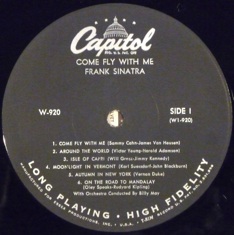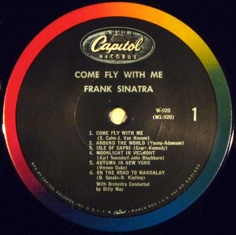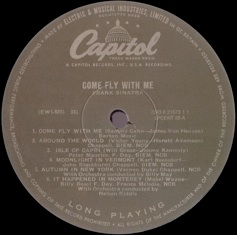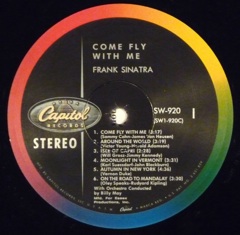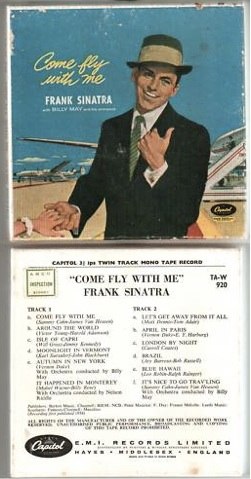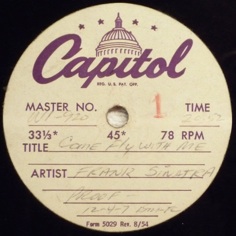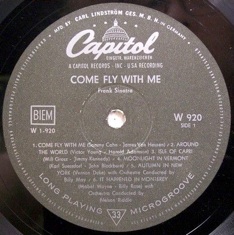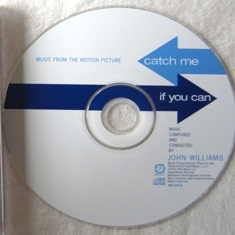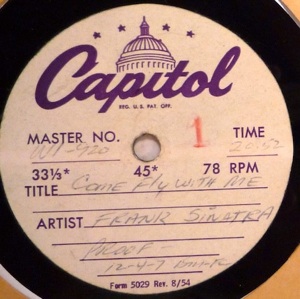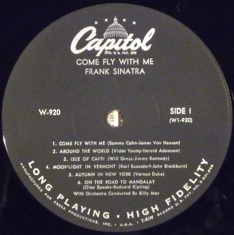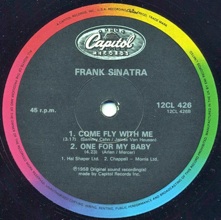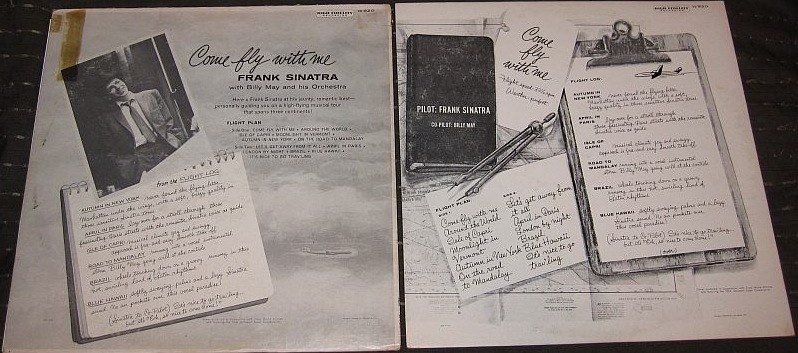

iTunes and ProStudioMasters.com
provide free clips of all songs sampled on this page. All clips, with the exception of 15 seconds of “Moonlight in Vermont,” fall within the free sample windows, as linked.

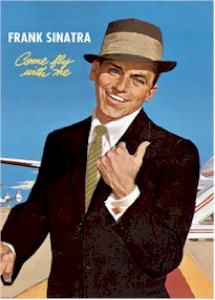
Recorded October 1, 3, and 8, 1957
Arrangements: Billy May
Conducted by Billy May
Produced by Voyle Gilmore
Released January 6, 1958 (mono);
November 27, 1961 (stereo)
In early October of 1957, Sinatra and Billy May and the orchestra gathered in Capitol Studio A, and, as was the case with every Capitol album prior to this one, the sessions were recorded in mono via the tried-and-true Capitol set-up of ten or so well-placed mics, mixed live in the studio’s control room, with chamber reverb also added live during the sessions. Additionally, as with Where Are You in spring of ’57, but not for the mono-only A Jolly Christmas sessions that followed, the sessions were also recorded remotely (in a makeshift facility upstairs) on 3-track tape via fewer microphones, and for the second stereo album in a row, gremlins beset the stereo gear, this time adversely affecting the right stereo channel on the third and final session, at which five songs were recorded. Steve Hoffman explains that “the late John Kraus told me that the microphone preamp in their makeshift console was malfunctioning, not the microphone itself.”
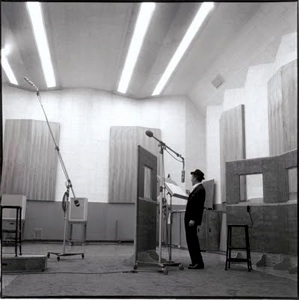
The photo above, regardless of its actual provenance, shows the general concept of how the minimally-miked stereo recording of this album took place. While the mono version used around ten (relatively) close-in mics, the stereo recording was done with only a few mics, and at great distance from the players, using tall stands such as the one visible at the left of the photo. In mono, then, while the marimbas and guitar and drums and (notably) bass were picked up via close miking, in stereo the entire band was picked up via these distant mics, what I’ve (jokingly) referred to as the MOTLMOTRPMMS technique. (MOTLMOTRPMMS = Mic Over There on the Left, Mic Over There on the Right, Plus a Mic in the Middle for the Soloist.) In the case of Capitol’s 3-track vocal recordings of this era, the stereo mics were completely separate from the mono recording, while the vocal mic was split between the mono and stereo setups. In other words, when reference is made to the mono and stereo mixes of this album, they are not different mixes in the usual sense of the phrase, but are actually separate, simultaneous recordings, with different balances and different tonal characteristics.
ON ALL CLIPS BELOW, THE MONO MIX IS HEARD FIRST, THE ORIGINAL STEREO MIX SECOND, unless stated otherwise. (All clips fall within the sample window for either ProStudioMasters.com or iTunes. No free music giveaways here.)
Session #1: October 1, 1957 - Big Band (plus mandolin, tuba, percussion), no strings
From a recording standpoint, things start well enough. This first session has no strings, and the stereo recording, while a little skimpy in the rhythm section, is quite effective on the whole, especially when the auxiliary percussion is allowed to shine.
iTunes and ProStudioMasters.com provide free clips of all songs sampled on this page. All clips, with the exception of 15 seconds of “Moonlight in Vermont,” fall within the free sample windows, as linked.
•On the Road to Mandalay - AUDIO CLIPS: https://app.box.com/s/ntcm78fw7tv6rbkp86xtypnu3dco9kz0
•Let’s Get Away from It All - AUDIO CLIPS: https://app.box.com/s/c09wp5u94b1jvhovdltqj2cjrudhzrkk
•Isle of Capri - AUDIO CLIPS: https://app.box.com/s/vrsugc2zd51hx57es95kvawyhc8hbf17
Session #2: October 3, 1957 - Emphasis on the Strings
•Autumn in New York - https://app.box.com/s/oeruq6wsq2sy0pmmtwpe7m59qkg0i9ae
Also, somebody near the right stereo microphone starts snapping their fingers, audible only in stereo: https://app.box.com/s/0i82c5j423vwyeoqk39zodt18u2mkdgg
•London by Night - https://app.box.com/s/xb1gbp32gumnpbwjvwzp0l00ltpvxdku
•April in Paris -
Clip One: In the intro, on the phrase “I never knew the charm of spring,” there is distortion on the original stereo mix that is not apparent on the 1987 CD stereo remix by Larry Walsh. Here it is three times: mono, original stereo, stereo remix: https://app.box.com/s/85iv4nog811dsx0mg0dv7zzk63hwp1u6
Clip Two: There are two wonderful, subtle touches in Billy May’s arrangement that are much clearer in mono. One is the delicate piano phrase under Frank’s first utterance of the phrase “April in Paris,” and another is a little harp gliss right after the word “Paris” much later in the song. Here they both are: https://app.box.com/s/2hdcf0gw7hh9xqjhq6w73mhnxss0typj
Clip Three: https://app.box.com/s/a6th8yjtzyy2tcqwwadhirckelxmc1ve
•Moonlight in Vermont - A few years back, the curator of the wonderful “apileocole” Nat “King” Cole website pointed out the creative use of the Capitol echo chambers on Nat Cole’s 1960 recording of “Poinciana,” in which the original mixes found Nat slowly disappearing into the reverberant ether at the end of the song, noting that on the remix done many years later, the effect was abandoned, either intentionally or by accident. Along those lines, Sinatra’s 1957 recording of “Moonlight in Vermont,” as mixed live-to-mono in-studio on this date, also featured “for-effect” reverb at the last word of the song, continuing into the instrumental tail that followed. The three-track tapes, meanwhile, were recorded completely dry, and when a stereo mix finally appeared late in 1961, that reverb effect, either intentionally or accidentally, was nowhere to be heard. Here is a comparison of the two: https://app.box.com/s/rk7ndlbb6yreawylnmb1j8sashzkg5y2

iTunes and ProStudioMasters.com provide free clips of all songs sampled on this page. All clips, with the exception of 15 seconds of “Moonlight in Vermont,” fall within the free sample windows, as linked.
Session #3: October 8, 1957 - All Hands on Deck
This is the session with the notorious distortion problem in the right channel that probably caused the stereo release to be delayed for nearly four years.
•Blue Hawaii - Distortion problems are pretty minimal on this, the first song recorded at the session. You will hear two brief passages in mono and stereo. First, the opening seconds, which contain no distortion but which illustrate well the different character of the two recordings; and second, the distorted flute passage: https://app.box.com/s/4wjzjk109m0khx3rz3rjkjdvy9hsu6cl
•Come Fly with Me - Several spots are distorted, but the most obvious problem spot is the forte brass during the instrumental passage in the middle. Here it is in mono, original stereo mix, and 1987 CD remix: https://app.box.com/s/6lh3uyep75offivllnmrxxcmtw4gpo8t
•Around the World - Again, multiple spots are distorted in stereo. Here are two of them, in mono, original stereo, and remixed stereo:
Clip One: https://app.box.com/s/xl15tkvwo1lbk6cgeaaus55j1bglk1bg
Clip Two: https://app.box.com/s/vc2la67agmrcyy1vew5poy8qyxrn1ks1
Note that on clip two, for the stereo remix, the echo chamber is used creatively to help mask the distortion problems.
•It’s Nice to Go Trav’ling - Distortion crops up in several spots in stereo, but here are the worst offenders: https://app.box.com/s/vrqv2oqze6savjzuueu92vb5t0bpbr40
•Brazil - They saved the most problematic recording for last!
Clip One: Some seriously distorted sections: https://app.box.com/s/xycjkig1vqumnlyuhs47ef37bh4fnwxi
Clip Two: Maybe the most obviously out-of-balance spot on the entire album, mono first, then stereo: https://app.box.com/s/uy13heqifjp6d7s3tzvsumtn4p01hy6e
Clip Three: Just for fun, one of the coolest Billy May “effects” on the album, the “group yell” (for lack of a better term) going on in the background while Frank sings “twilight dims,” STEREO first, mono second: https://app.box.com/s/pzz05fvj05cb0kza58qj0moiogn2gg3a
Originally recorded in both mono and stereo in October of 1957, and released in mono only in January of 1958, Come Fly with Me remained a mono-only release for just under 4 years, so even well into the stereo era, most people who heard this album heard it in mono, not stereo.
AT RIGHT: photos of the original promo label, courtesy SH.TV member “Blackie,” and July ’58 mono British pressing, courtesy SH.TV member “stevelucille.”
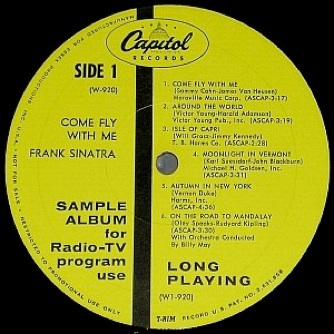
•1957 acetate: acetate.wav
•D7 LP: ClipD7.wav
•N19 LP: N19.wav
•2009 G1 LP: 2009-NORM_03.wav
•2014 LP*: 2014BFerr1.wav
*courtesy “bferr1”
•1987 STEREO CD remix: On The Road To MandalayWalshClip.wav
MONO RELEASES Several brief mono samples are available below. Thanks to SH.TV members AxeD, BeachBoyDW, BFerr1, Chris R, Greg1954, and Shicorp for providing assistance and/or mono samples for comparison, all in WAV format.

BELOW: SH.TV member “Blackie” sent along this photo showing the two rear-cover variations on USA mono pressings. The one on the right was the initial version; the one on the left came into use when the stereo version was released in the early 1960s.
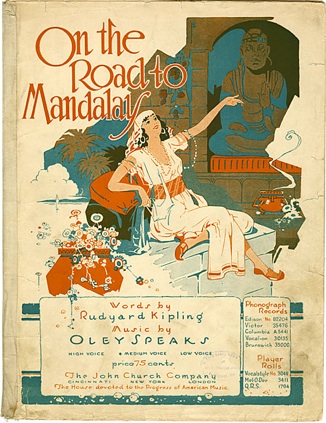
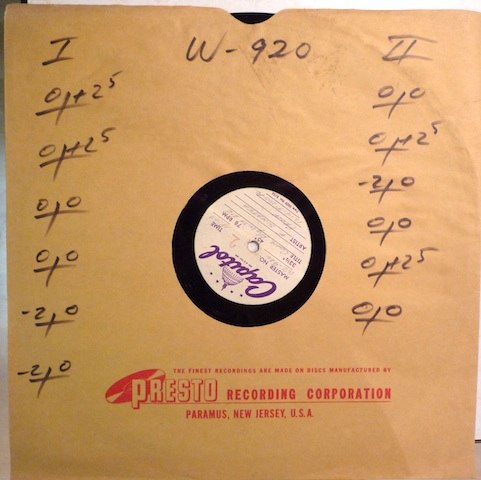
On December 4, 1957, a little over a month before mono LPs hit store shelves, a full-length, 2-sided mono “proof” acetate was cut at Capitol, complete with mastering notes on the sleeve. If I read these notes correctly, four songs had a 2 decibel 5kHz HF boost, three songs had a 2 dB cut at some other frequency, and five were cut totally flat (but still with a very audible limiter in the chain), all from the mono session tapes.
To hear a collage of brief clips from
the pre-release “proof” version of the album, click the photo at right

MONO COMPARISON CLIPS
FROM THE TITLE TRACK, “COME FLY WITH ME” - Click photos for audio
iTunes and ProStudioMasters.com provide free clips of all songs sampled on this page. All clips, with the exception of 15 seconds of “Moonlight in Vermont,” fall within the free sample windows, as linked.
ABOVE: 12” acetate “proof” LP, dated December 4, 1957, just over a month prior to release of the mono LP
ABOVE: Original German mono pressing, courtesy SH.TV member Chris R. (Note the track listing on the label. “It Happened in Monterey” replaces the intended 6th track, “On the Road to Mandalay,” due to copyright problems with that track in Europe.)
ABOVE: Original D7 USA mono pressing
Above: circa 1966 N19 USA mono pressing
ABOVE: 2002 MCA (licensed) digital release of the mono version of the title track only, from the Catch Me If You Can soundtrack CD, Mastered by Patricia Sullivan, courtesy SHTV member “shicorp.”
ABOVE: 1997 EMI Centenary Edition mono pressing, courtesy SH.TV member BFerr1. (Note the track listing on the label. Assumedly for historical accuracy, “It Happened in Monterey” replaces the intended 6th track, “On the Road to Mandalay,” due to former copyright problems with that track in Europe.)
Above: 2014 mono LP, mastered by Ron McMaster, courtesy SHTV’s “AxeD.”
Above: 2009 “From the Vaults” mono pressing, erroneously bearing a stereo label. G1 pressing, mastered by Ron McMaster.
MONO
REEL-TO-REEL
(below)
Above: UK 3.75 ips twin-track mono release, on a 4” Emitape reel, catalog #TA-W 920.
Click photo above to hear:
•A brief clip from my D7 pressing
•At “beat the birds,” a segue into TA-W 920.

ABOVE: Original D5 USA mono pressing
Above: 2014 HD mono download
MORE MONO COMPARISON CLIPS
FROM “ON THE ROAD TO MANDALAY” - click links below
iTunes and ProStudioMasters.com provide free clips of all songs sampled on this page. All clips, with the exception of 15 seconds of “Moonlight in Vermont,” fall within the free sample windows, as linked.
ORIGINAL USA REAR MONO COVER
LATER USA REAR MONO COVER
At left: STEREO 1986 UK 12” Single (b-side to Nice ‘n’ Easy )
STEREO

